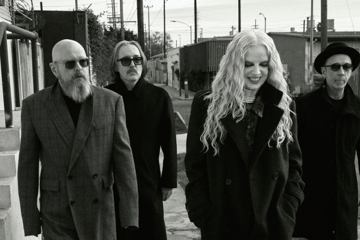'Get Out' Is The Horror/Comedy/Satire That You've Been Waiting For All Year
'Get Out' immediately positions Jordan Peele as a compelling new voice in American cinema.
get out

Horror films have long played with the fear of the other: rural rednecks, foreign menace, communists, female sexuality, lawless delinquents, children. These fears usually are white suburban anxieties, playing on the news-media-stoked scares of lawless lower-classes, marauding immigrants, kids-these-days. Whilst there’re countless movies where wealthy white people are punished for their greed by supernatural forces (or, y’know, Frogs), few are the films in which wealthy white people are, themselves, the figures of terror.
Those few films are, notably, satires; like Brian Yuzna’s Society or Wes Craven’s The People Under The Stairs. And, now, Jordan Peele’s brilliant, breakout flick, Get Out. As one half of sketch-comic pair Key & Peele, the debut director has a long history of skewering the shifting grounds of contemporary race relations, and here his simple premise —a young black man goes to meet his white girlfriend’s parents at their palatial upstate property, terror ensues— comes loaded with social resonance. Especially given its villains aren’t hardline, unrepentant, Republican racists, but self-satisfied liberals displaying a soft racism; the kind of people who boast about knowing Tiger Woods, trumpet their support of Obama, and peddle stereotypes of black athletic prowess and sexual potency. Well, that and a dark, blood-splattered secret, which comes steeped in America’s flesh-peddling history of slavery.
Don't miss a beat with our FREE daily newsletter
Daniel Kaluuya —the cult-Brit-tv hero from Skins, Black Mirror, and Babylon— finally gets a leading-man turn as a quiet photographer, uneasy about going to meet the family of his new squeeze, Allison Williams. His comic-relief homie, Lil Rey Howery, issues a due warning —“don’t go to a white girl’s parents’ house”— but Kaluuya has been conditioned to go along with this; to smile and offer “it’s all good” and “it’s fine”; shrug off slights, hurts, anxieties.
In his long-awaited leading-man turn, Kaluuya is amazing, managing to convey depth, difficulties, and contradictions largely with his eyes, body language, nervous smiles. His counterpoint, in both character and performance, is Catherine Keener, who plays Williams’ mother, a therapist who’s a fantastic study in passive-aggressiveness, her air of accommodating ‘chill’ wielded like a weapon.
When Keener hypnotises Kaluuya, and he descends into the ‘sunken place’; falling backwards, through the floor, until he’s buried in the darkness, and his own blackness. It’s both a fantastic visual image —at once reminiscent of Stranger Things’ Upside Down and the surrealist, symbolist dreamworlds of Hitchcock’s Spellbound— and a loaded symbolic device: his traumatic history used to silence, cow, repress him.
The film is about Kaluuya clawing his way out of this place, escaping imprisonments both literal and psychological. He does so wielding croquet mallets and elk heads, which suggests the approach of the film: violent retribution and final emancipation coming with weighty symbols and satirical sedition. Peele, showing a deft directorial touch, handles the material perfectly, displaying patience, calmness, and certainty.
Get Out succeeds as well-judged, well-made whole, but also works for those who come at it for singular pleasures. If you’re here for genre tropes, scares, and nods to other horror films (most notably The Stepford Wives), then it succeeds. If you watch it just as comedy, it’s hilarious (Williams googling ‘Top NCAA prospects’ is a moment of doubling-back brilliance). And if you watch it solely as satire, then it’s an audacious, intelligent prodding of the painful fault lines of American society. That it’s all three things at once elevates Get Out above simple genre, and immediately positions Peele as a compelling new voice in American cinema.
raw

It’s the kind of perfect marketing that money couldn’t buy: at the Toronto premiere of Julia Ducournau’s cannibal rumpus Raw, an ambulance was called after a couple of patrons passed out. Of course, it likely was the kind of perfect marketing that money could indeed buy, as internet sleuths soon suspected the great ambulance bait was but a buzz-building hoax. Horror-films have been the host for Barnum-esque salesmanship since the days of William Castle and Alfred Hitchcock, and Raw is the latest to use tales of audience trauma to get bums on seats; a Los Angeles theatre getting in the game by providing vomit bags to Raw audiences.
Whether it’s the sight of dog corpses dismembered in a lab, viscera sucked from the exposed brain of a car-crash victim, wads and wads of hair vomited out, or a detached finger gnawed on like a chicken wing, there’s plenty of provocation in Raw. If you’re the kind of viewer who gets queasy at the sight of fake blood, prepare to feel swamped by nausea at the sight of a class of kids verily dumped in it.
They’re the incoming students at a veterinary college, whose elaborate orientation-week hazing rituals involve eating gizzards, getting dowsed in blood, splattered with paint, and routinely (sometimes sexually) humiliated. One of these students is Garance Marillier, a 16-year-old straight-A vegan who professors condescendingly call “the prodigy” from the moment she arrives on campus. Older sister Ella Rumpf is, in contrast, the campus’s wild party girl; the film’s drama as anchored in their sibling rivalry and familial intimacy as it is in their mounting, insatiable bloodlust.
Here, the carnal coming-of-age symbolism is clear: the sisters’ discovery of their cannibalist desires inextricable from their sexual awakening. Given horror’s long-standing rep as macho genre, depicted from —and for— the male gaze, Ducournau is out to upend old tenets. There’s a real subversion of predation, herein: the true horror the notion that a young woman could be the agent of animalist desires, not just the object of them.
This primal-lust set-up is elemental, but the filmmaking is brilliant, even bombastic. Its dynamic use of light and dark, ear-splitting party scenes, extended sequences of disorientation, and final smash-cut to credits all suggest the influence of Gaspar Noé. In fact, for certain cineastes, Raw will delight as extended homage to the New French Extremity of the early century: Ducournau openly influenced by the blood-splattered, psycho-sexual body-horror of Marina de Van’s In My Skin and Clare Denis’s Trouble Every Day, with the presence of old NFE pin-up Laurent Lucas feeling like a particular tip of the cap. It’s common for debutantes to wear their influences on their sleeves, sure, but uncommon for first-timers to make something this audacious, eye-catching, and stomach-retching.
free fire

Free Fire is the latest film for Ben Wheatley, but though it shares High-Rise’s lurid ’70s wardrobe and facial hair, it shares none of its formal daring. In fact, it doesn’t even possess the formal daring of Reservoir Dogs, the film it’s openly aping. Here, a top-line cast —Armie Hammer, Cillian Murphy, Brie Larson, Jack Reynor, Sam Riley, Michael Smiley, Sharlto Copley, Noah Taylor— wear an array of wild wigs and polyester suits, playing the participants in a black-market deal for a cache of weapons. It all takes place in one night, in one warehouse in Boston; the economically-depressed, post-industrial wasteland evoking the film’s essential nihilism.
The deal in question soon goes sideways, with macho bluster, fragile ego, and simmering violence spilling over. The insults start flying, then the bullets. Free Fire is one long shoot-out; though at just 90 minutes, ‘long’ isn’t the right word to describe it. The whole thing is staged as a comedy, with every grievous wound played for laughs, every death delivered with the pulpy giddiness of a B-movie. It’s a questionable comic premise, at best, and a film of limited ambition. Where Wheatley has previously taken simple ideas to strange places —as with 2013’s 17th-century-soldiers-shroom-trip A Field In England— here, it rather feels as if he’s boxed himself in.
berlin syndrome

After 2012’s Lore took Cate Shortland to Germany, she stays with Berlin Syndrome. As its title suggests, the film is a study of Stockholm Syndrome, set in Berlin. Teresa Palmer plays a mousey, insecure Australian girl, who, freshly landed at a hostel, sets off around Kreuzberg with a camera around her neck. She meets Max Reimelt, an odd, handsome, intense local. Soon enough, they fuck; a classic example of the ephemeral unions forged by travellers. Only, what at first seems fleeting turns permanent, as Reimelt locks Palmer in his isolated warehouse apartment; the traveller turned prisoner.
Melanie Joosten’s novel, on which the film is based, told its story of captor/captive from dual perspectives; exploring their relationship from either side. And, when Shortland follows that set-up, it’s striking: a film seemingly about one girl’s backpacking nightmare radically changing when it abandons her, and follows Reimelt off to work, sees how he remains a functional member of society even when he’s got a hostage back at home.
At first, Berlin Syndrome plays as an exploration of the dynamic —at once hostile and homely— between the pair; charting how their relationship veers from sexualised to desexualised and back; teasing at the notion of male desire as possessive. But, after its unexpected narrative detours and surprising sympathy for its devil, the film, inevitably, has to submit to genre tropes; become, simply, a modern-day riff on the intimacy thriller. There’s worse fates, I suppose, yet, as the film grows less individual and more generic, the conventions work against its narrative: its climax playing as anticlimactic.
their finest

“Don’t confuse fact with truth, and for God’s sake don’t let either of the two of them get in the way of the story,” pronounces Sam Claflin, sage vet teaching plucky secretary-turned-screenwriter Gemma Arterton in the ways of penning a propaganda picture. In this work of bittersweet, witty historical fiction, it’s WW2 in London, and with residents facing the daily barrages of the blitz —spotlights in the sky, rubble in the streets, sirens sending citizens scurrying off to huddle in tube stations— England needs a cinematic story to rally the troops, embolden the populace, and convince the Americans to join the war.
And so, the Dunkirk evacuation —suddenly, strangely, re-emergent in the cinematic zeitgeist, with the imminent on-screen arrivals of Christopher Nolan’s Dunkirk, Joe Wright’s Darkest Hours, and Jonathan Teplitzky’s Churchill— is to be rewritten, no longer defeated fleeing, but glittering exemplar of British bravery and sacrifice. “Why do you think people like films?” says Claflin. “Story has structure, shape, purpose, meaning. Unlike life.”
In a device that’s once illustrative and a little on-the-nose, all these lessons about storytelling illuminate the story itself. And, as the film-within-the-film progresses from screenplay to production, all the notes on its necessary story beats, emotional content, romantic developments, happy endings, audience expectations, and overall ‘worthiness’ grow more and more meta. As, in many ways, does Bill Nighy’s comic turn, in which his haughty actor is always delivering a kind of performance, whilst offering ongoing, lionising commentary on the thespian craft.
Lone Scherfig, the Danish Dogme alumnus best known for An Education— depicts the distant past with an old-fashioned period-piece gloss, and this, too, grows meta; as the film-within-the-film is recreated in authentic vintage style. All the duality and layers are eventually squashed together when the emotional climax of Their Finest is the emotional climax of the movie within: Arterton heading off to the cinema to see the fruits of her labours, the enthusiastic reception of the audience within out to sway real-world crowds.
rules don't apply

In Rules Don’t Apply, the title is said aloud, over and over. Then Lily Collins writes a song in which the phrase is the recurring refrain. Then she plays the song again. Then, the film ends with Warren Beatty listening to a recording of her playing the song. And, just in case you didn’t get it, the song’s played again in the credits. If you’re a fan of that gag in the Apatow Love TV show of making up songs about movies that don’t have theme-tunes, you’ll find it funny the first few times. But, by the end, even the most ironic viewer will never want to hear it again.
This tendency towards literalisation plagues Rules Don’t Apply, instantly infamous as Warren Beatty’s latest disaster. The old Hollywood pin-up had yearned to make a film about Howard Hughes since the early-’70s, and, finally, scared up a $25mil budget —and an amazing cast— to do so. But, having been beaten to the biopic punch by Martin Scorsese’s The Aviator, instead of a rollicking ride of billionaire excess and Spruce Goose insanity, what he serves up is a tepid love-triangle populated with tired clichés.
It’s the kind of film in which a small-town guy (way-handsome future-Han-Solo Alden Ehrenreich) and smaller-town gal (immaculately-eyebrowed Lily Collins) arrive in Los Angeles in the 1950s and Hooray For Hollywood unironically plays. For all the sins Rules Don’t Apply commits —leaden jokes, telegraphed dramatic developments, the burnishing of Beatty’s ego— nothing grates more than its romanticised depiction of the Good Old Days; the kind of movie-biz nostalgia the Coen Brothers mine for weirdness, comedy, and kitsch here depicted with utter earnestness.
slack bay

If a fat man in a bowler hat falls over on a sand dune and rolls like a beach ball down its slope, do you consider it the height of hilarity? If not, there’s going to be moments in Bruno Dumont’s Slack Bay that’ll sap you of your will to go on. Dumont found fame as the grumpy, glowering Catholic of the new French extremity: his stark, savage, miserablist movies out to punish both character and audience; the results sometimes sublime (Camille Claudel 1915), sometimes salacious (Twentynine Palms), forever provocative. With his 2014 TV series Li’l Quinquin, though, Dumont took an unexpected turn towards comedy. And, here, he goes full throttle, serving up a parade of old-timey slapstick, mugging zaniness, and panto buffoonery; with Juliette Binoche’s stagey turn turned up to 11.
But, beyond the fat-man-falls-over gags, there’s enough genuine strangeness and unexpected savagery to make Slack Bay more than some embarrassing curio. Set in a seaside hamlet in the early 20th-century, it’s a classic class satire, a family of haughty Parisian toffs descending on the ‘scenic’ seaside and colliding with the resentful local yokels. One salty rural family turn out to be cannibals, and when Dumont makes comedy out of grizzly murder and gleeful butchery, the film finally comes to life; the director clearly being better at horror than humour.
things to come

Mia Hansen-Løve’s films don’t have to be taken —or critically appreciated— as some kind of cinematic tonic, but the best time to watch one might be, say, after you’ve just suffered through a Fast & Furious movie.The 36-year-old auteur’s movies may seem slight by the normal measures of melodrama and machismo, but they’re remarkable depictions of the passage of time, slipping through the years with irregular rhythms. Whether they’re about grieving (The Father Of My Children), youthful passion and idealism giving way to growing up (Goodbye, First Love), the birth of French house music (
Isabelle Huppert, the world’s greatest actor, plays its central character, a philosophy professor whose life-as-she-knows-it is suddenly, radically changed. Soon after her husband (André Marcon) announces he’s having an affair (“Why tell me? Couldn’t keep it a secret?” she mocks), her suicidal mother (French screen legend Édith Scob) dies. With that, her elemental roles of wife and daughter are suddenly gone, and Huppert wanders, in search of new meaning for her life; these years, liminal and mercurial, reminiscent of her 20s. But, after she lands at a commune of intellectuals and radicals in the mountains (where a beloved former student, Roman Kolinka, has retired from the world), she realises she can’t return to her old anarchist idealism.
Befitting its maker, Things To Come is not a film of plot, but charmed moments; as when Huppert, struggling to get a good signal on her phone whilst walking a muddy beach, lets loose an exasperated string of expletives. The environments are evocative, the weather palpable. Hansen-Love will turn whole stretches over to moments of sweet stillness therein: lying down in the sun on a hillside to read a book, or swimming in a mountain stream at the height of summer. But then whole seasons, or years, will pass in an edit, and the melancholy feeling of life passing will slowly gather, the emotional currents running surprisingly deep.
summer 1993

The Spanish Film Festival opens around the country this week. And whilst there’s a handful of definite highlights —Raúl Arévalo’s slow-burning study of vengeance The Fury Of A Patient Man; Alberto Rodríguez’s Marshland follow-up Smoke & Mirrors; and Álex de la Igelsia’s latest satirical genre rumpus, The Bar— the definite standout is Carla Simón’s astonishing debut, Summer 1993. It’s one of the most profound depictions of childhood ever brought to screen. Its lead actors are six (Laia Artegas) and four (Paula Robles), and Simón manages to balance the unrestrained naturalism of her tiny stars with the story-telling devices of drama; an achievement evocative of the film’s greater realist mise-en-scène.
Following the death of her mother, an orphaned Artegas goes to live on the remote country property of her aunt (Bruna Casí) and uncle (David Verdaguer of 10.000km). Echoing the film’s marriage of memoir and cinema, it was shot on the actual property Simón herself ended up at as a six-year-old. It was obviously a vivid experience, as the director captures the details of environment and season —swimming in rivers and pools, playing near-naked in the garden, picking plums from verdant trees, the thrum of insects— and the feeling of being a child, thrown into a new situation, making sense of the world around you.
Befitting a film about young childhood, Summer 1993 is about what a child understands and doesn’t; how a six-year-old processes death, grief, unwanted change. The overheard words of adults clarify things for viewers, but not so much for the character; suggesting, only, a realm to which you’re not yet privy, a language that you’ve not yet learned to speak. As much as it’s evocative of childhood, it’s also evocative of parenthood; Simón understanding how much time is spent attempting to cajole kids into doing things —tying shoes, getting out of the bath or car, tidying up— they’re refusing to.







